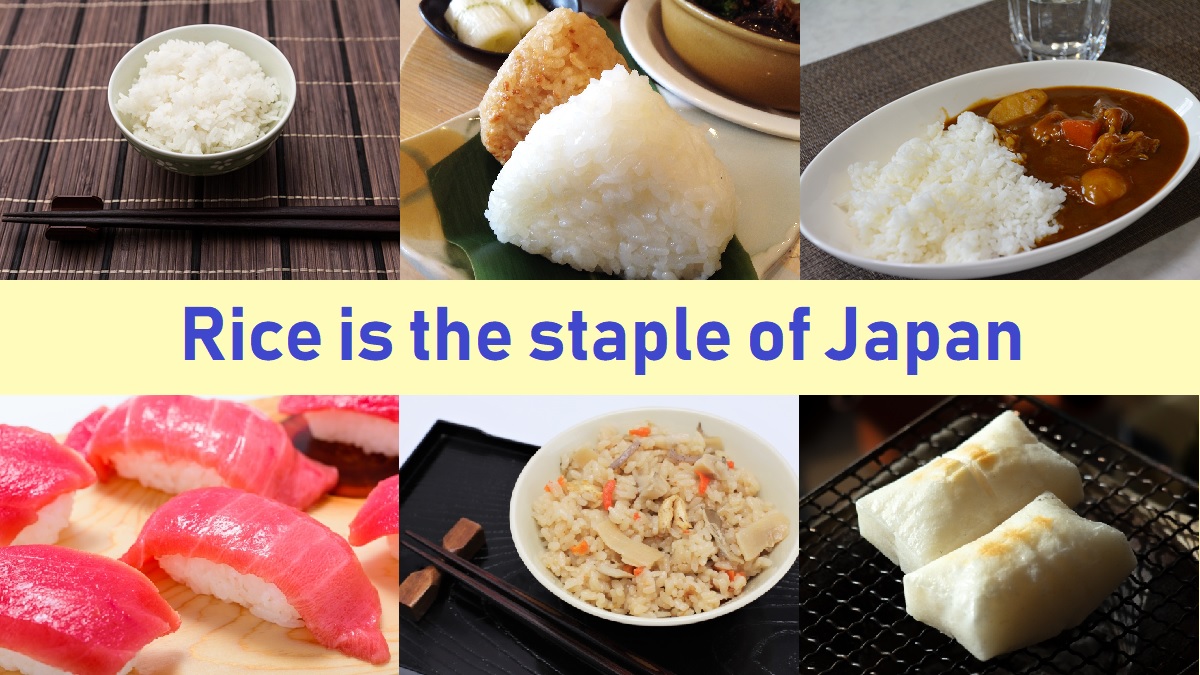Rice and its various cooking, Mochi, Bread
Rice
Rice in Japan
The kind of rice harvested in Japan is "Japonica rice".
The boiled Japonica rice is sticky and rather sweet, and it is less stiffened even when it becomes cold.
Another kind of rice is "Indica rice" and the grain is thinner, longer and less glutinous than Japonica rice.
It is mainly eaten in the southern part of Asia and Latin America.
The rice that Japanese people eat every day and use for Japanese cuisine is Japonica rice.
Rural scene of Japan
The rice is cultivated in most areas of Japan.
Probably, I think the scenery from the window of train or bus is almost rice field when you visit in the rural area.
In spring, farmers let water flow to rice fields and plant rice seedlings there.
Until the end of tsuyu (rainy season between spring and summer), we can see the scenery of rice field like many square ponds.
In summer, rice grows up.
We can see the rice fields like green field of grass.
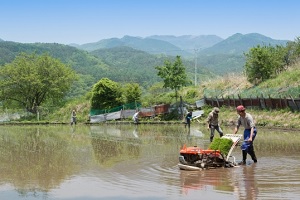
Rice-planting in spring
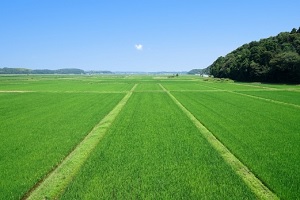
Green rice field in summer
In autumn, the color of rice changes from green to yellow and rice bears.
It looks like golden carpet.
After harvesting, we can see stubble fields.
Until next spring, the fields are allowed to lie fallow.
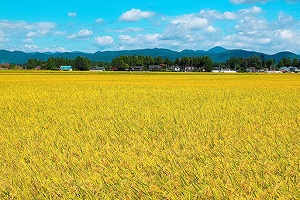
Ripe rice plants in autumn
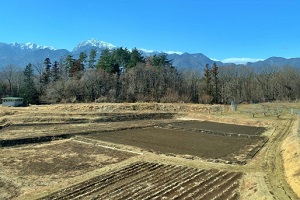
Rice field in winter
How to cooking rice
Harvested rice is threshed, then the grain is polished by milling machine.
We can buy the polished rice at the shop.
The most basic method of rice cooking is boiling in water in Japan.
- Wash raw rice with water.
- Put the rice into a pot, and add 1.2 times the amount of water to rice.
- Put the pot with a lid over high heat.
After this, don't open the lid until finish. - When it begins to boil, turn the heat to medium.
- Turn off the heat, when water is boiled away. You can't look into the pot, so this requires years of experience.
As a rough guide, it is for 30 minutes. - After waiting for about 15 minutes, you can eat the tasty rice.
This is the traditional procedure, but most people today cook rice with electrical or gas rice cooker.
It cooks rice automatically from above (3) to (5).
Boiled rice is very white and soft, and we feel slightly sweet in our mouth.
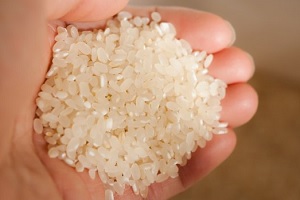
Raw polished rice
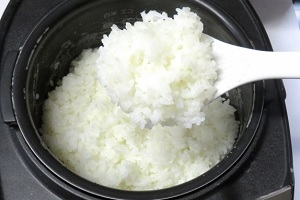
Just cooked hot rice
Basically, the boiled rice is put into a small bowl and is served.
You hold chopsticks on your dominant hand, and hold up the bowl by another hand.
Then, you put the rice into your mouth from the bowl close to the mouth with chopsticks.
That is the basic way to eat rice in Japan.
Topping for boiled rice
We usually eat boiled rice with a small rice-bowl.
The hot boiled rice is tasty.
The taste is slightly sweet but is simple.
So, we sometimes want to add any different taste to the rice.
There are a few foods for topping on the rice.
They have a little strong flavor, so they make rice more tasty by topping them a little.
Furikake is dry seasoning.
It consists of salt, chopped katsuobushi (dried and ground bonito), sesame seeds, chopped nori (seaweed), etc.
Various furikakes of unique combination of the ingredients are sold.
Tsukudani is a food that an ingredient are simmered in shoyu (soy sauce) and mirin (seasoning of sake and sugar).
The color of any tsukudani is very dark by boiling in thick soy sauce.
As the ingredient, seafood (small fish, shellfish, shrimp), meat or seaweed (konbu, nori) are simmered in shoyu (soy sauce) and mirin (seasoning of sake and sugar).
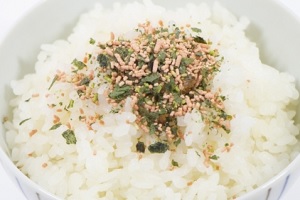
Furikake on rice
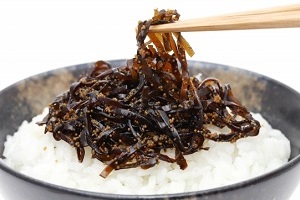
Tsukudani of Konbu
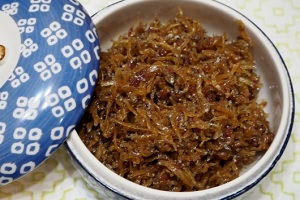
Tsukudani of small fish
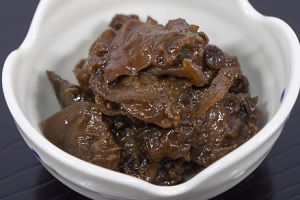
Tsukudani of shellfish
Natto is a Japanese popular fermented food of soybeans.
After stirring Natto and a little shoyu with chopsticks, it is put on on boiled rice and mixed.
The people who like Natto often do so.
For foreign people, it sometimes seems strange that Japanese people eat eggs raw.
But raw egg and hot rice are popular for Japanese people.
(Raw eggs in Japan have been sold under sanitary management of high quality.)
After beating a raw egg with a little shoyu, it is poured on boiled rice and mixed.
Many Japansese people like this.
It is called Tamago-kake-gohan in Japanese.
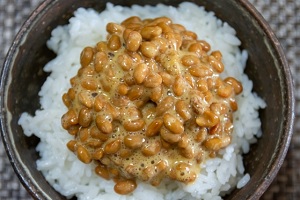
Natto on rice
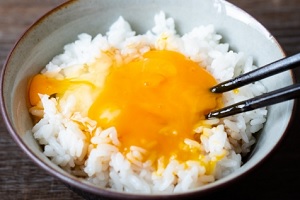
Tamago-kake-gohan
Various cooking of boiled rice
According to time and occasion, rice is cooked and eaten in various ways.
- Ochazuke : Hot water, hot green tea or dashi soup is poured on the rice in the rice-bowl.
Because we can shovel the watery rice into our mouth, we can eat rice rapidly or smoothly.
For adding salty taste, there are dried Konbu chips with salt or furikake for Ochazuke. - Onigiri : It is also called Omusubi.
It is a rice ball formed into triangle or oval shapes and wrapped in nori.
It is made by gripping hot boiled rice with both palms softly and forming it, so it is often made at home as the portable box lunch.
Generally, it is filled with umeboshi (Japanese salt plum pickles), salted salmon flakes, katsuobushi or any other salty or sour ingredient.
Most convenience stores stock various onigiris in many popular fillings and tastes.
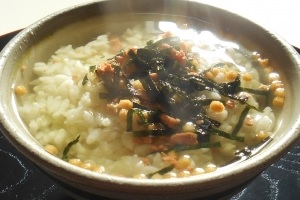
Ochazuke
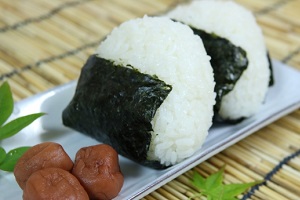
Onigiri
- Kayu : It is Japanese rice porridge. It made by boiling rice with 5 to 7 times the amount of water.
Because it is one of the healthy menu of Buddhist cuisine, we often make it when we are ill.
And some hotels prepare it as breakfast. - Takikomi-gohan : Before rice is boiled, dashi and shoyu are mixed into water. And generally chopped vegetables and mashrooms are mixed together.
Completed rice is very tasty, because it is flavored by soup and ingredients.
"Takikomi" means "boil and mix".
This is also called "Gomoku-gohan" (rice with various ingredients), "Aji-gohan" (tasty rice) or "Maze-gohan" (mixed rice).
In Kansai area, this is called "Kayaku-gohan" (rice with ingredients).
It is often served by cooking in a small iron pot in Japanese restaurant and is called "Kama-meshi".
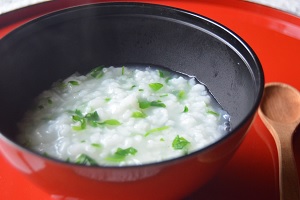
Kayu
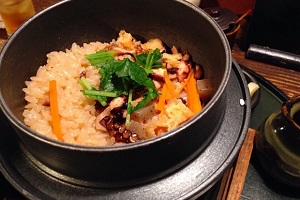
Kama-meshi
- Sekihan : It is made by boiling rice with azuki (small red beans), so the rice color becomes reddish brown.
It is made at auspicious occasion of own family or relatives. - Zosui : After eating up the pot dish, tasty soup remains in the pot.
Boiled rice is put into the pot, and is boiled for a few minutes.
It is the tasty Zosui.
It is similar to Kayu of tasty soup.
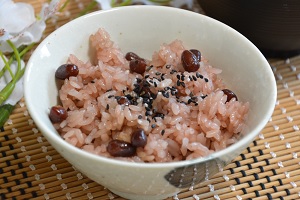
Sekihan
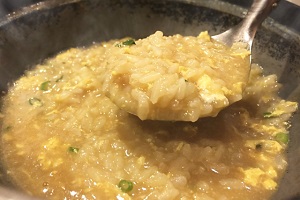
Zosui
- Sushi : Of course, sushi which is the most popular Japanese cuisine uses tasty vinegared boiled rice.
- Curry and rice : Curry originated in India, but it became a dish to eat rice deliciously in the Western style.
It is the most popular dish liked by everybody in Japan.
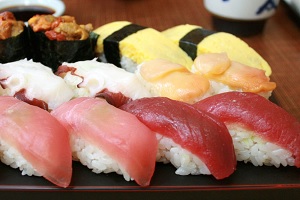
Sushi
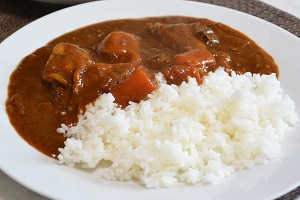
Curry and rice
Mochi
Mochi is translated as rice cake in English.
A little polite expression is Omochi
The rice for mochi is different from common rice and is very sticky when steamed.
The rice is called "mochi-gome".
Mochi is made by pounding steamed mochi-gome into sticky paste like bread dough.
Immediately after it is created, it is very soft.
But it gradually gets hard.
Recently, most mochi are produced in the factory and are sold in many shops.
Traditional mochi pounding is mainly held as the popular local event.
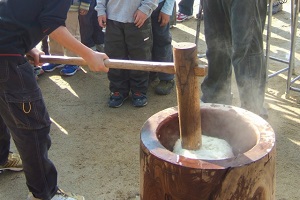
Pounding Mochi
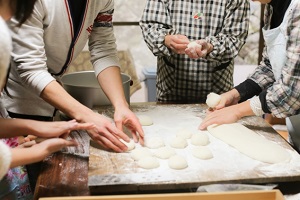
Making mochi after pounding
Since ancient times, mochi has been a food for the happy day in Japan.
Especially, there is a custom to eat mochi on New Year's Day.
During New Year's Days, special mochi is offered to the gods.
It is called as "Kagami-mochi".
Kagami-mochi consists of two round rice cakes and the smaller placed on the larger.
And an orange is put on the top.
It is decorated on household altar or important place in the house.
For the first breakfast of New Year, Zoni is served.
Zoni is the soup boiled with a piece of mochi, vegetables and a few other ingredients.
And decorated Kagami-mochi is eaten after the end of New Year's week.
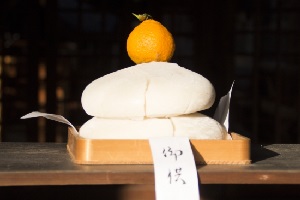
Kagami-mochi offered in Shinto shrine
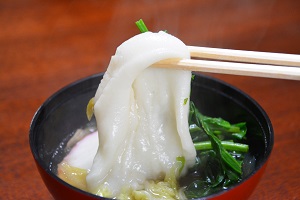
Zoni
Mochi is the rice substitute around New Year's days.
Broiled mochi is also eaten.
Mochi is used for an ingredient of Japanese confectionery.
In any area in Japan, mochi is used for some of the local confectioneries.
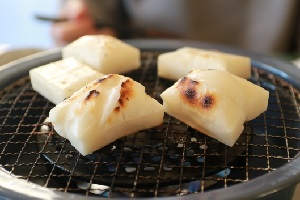
Broiling mochi
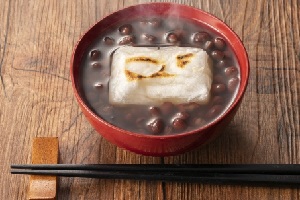
Sweets of red beans with mochi
Bread
Bread was introduced from Portugal in the 16th century.
So it is called as "pan" in Japanese, from pronunciation in Portuguese.
But popularization of bread was after the end of the 19th century, and it is not so old in Japan.
Today, many people in Japan eat bread for breakfast or lunch instead of rice.
Bread is, after all, a substitute for rice.
You can find some bakeries in any city, and you can get favorite breads at most convenience stores or supermarkets.
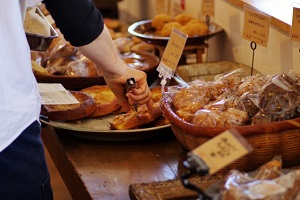
A bakery in Japan
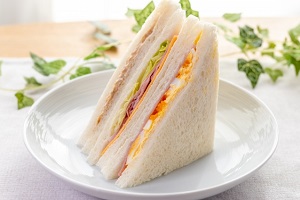
Sandwiches of tuna, ham and egg
Recently, not only general bread but also various types of bread are sold.
In Japan, very various fillings are used for bread and sandwich.
Probably, many foreign touists may experience a strange sensation.
For sandwich, hams and lettuce, oiled tuna flakes, boiled eggs with mayonnaise, etc. are the popular fillings.
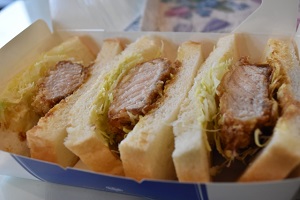
Sandwich of tonkatsu
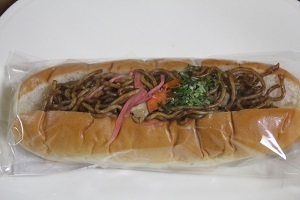
Sandwiches of yakisoba
And tonkatsu (Japanese pork cutlet), yakisoba (fried Chinese noodle) are known for foreigner as unique Japanese fillings.
Curry bread with thickened curry inside is mainly fried in oil.
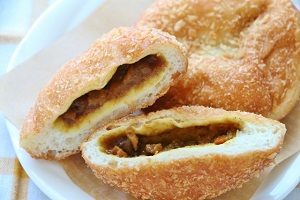
Curry bread
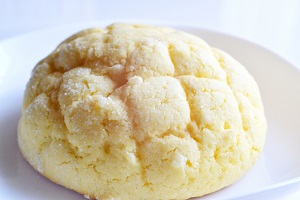
Melon-pan
Breads and sandwiches like confectionery are also popular in Japan.
"Melon-pan" (Melon bread) is popular as a unique Japanese bread.
It is sweet and has a flavor of melon.
An (sweet red bean paste), custard cream, strawberry jam have been the popular fillings for bread since early 20th century.
Sandwiches of fruits and fresh cream are also popular.
Recently, the sandwich with the colorful and artistic cut end is photogenic.
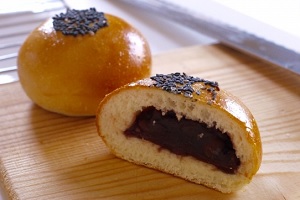
An-pan (An bread)
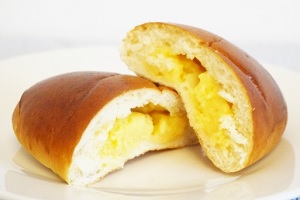
Cream-pan (Bread of custard cream)
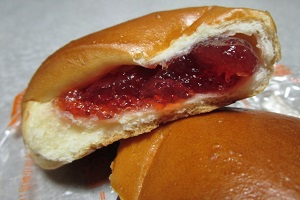
Jam-pan (Bread of strawberry jam)
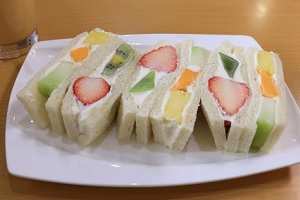
Fruits sandwich

